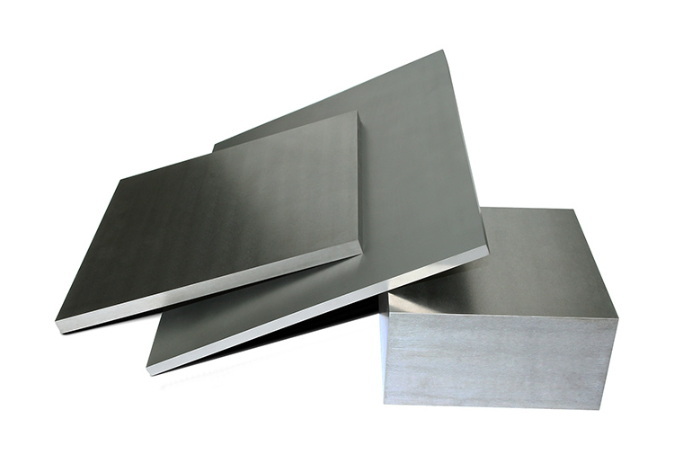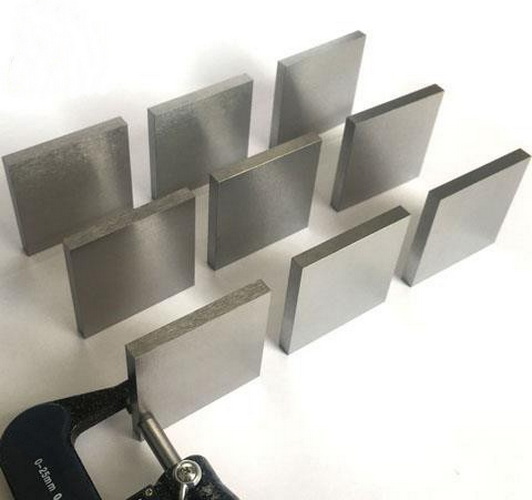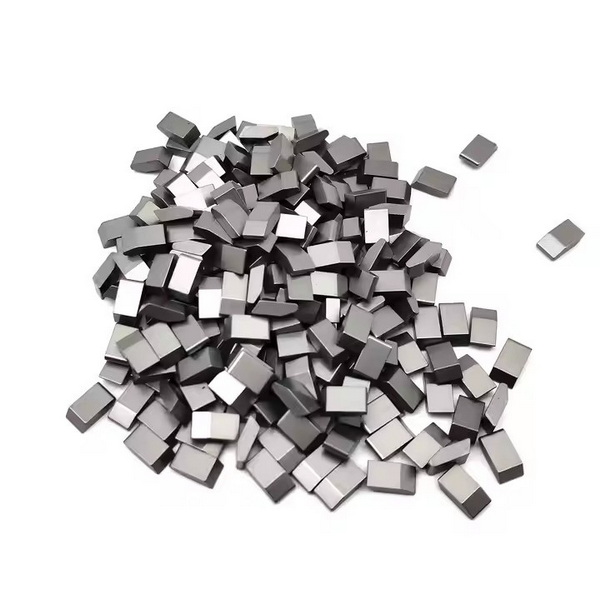Content Menu
● What is Tungsten Carbide?
>> Composition and Manufacturing
>> Properties of Tungsten Carbide
● Understanding Corrosion Resistance
>> Mechanisms of Corrosion
>> Factors Influencing Corrosion Resistance
● Corrosion Resistance of Tungsten Carbide
>> Behavior in Different Environments
>> Role of the Binder Phase
● Enhancing Corrosion Resistance
>> Alloying
>> Coatings
>> Surface Treatment
● Tungsten Carbide vs. Other Materials
>> Stainless Steel
● Applications of Corrosion-Resistant Tungsten Carbide
>> Oil and Gas Industry
>> Chemical Processing
>> Marine Industry
>> Other Industries
● Conclusion
● FAQ
>> 1. What makes tungsten carbide corrosion-resistant?
>> 2. How does the binder material affect the corrosion resistance of tungsten carbide?
>> 3. What are the best ways to improve the corrosion resistance of tungsten carbide?
>> 4. In what environments does tungsten carbide exhibit poor corrosion resistance?
>> 5. What are some typical applications of corrosion-resistant tungsten carbide?
● Citations:
Tungsten carbide is known for its exceptional hardness, wear resistance, and stability in harsh environments[2][7][4]. Its corrosion resistance is a critical property that determines its suitability for various industrial applications, including those in the chemical, petroleum, and marine sectors[7]. This article explores the corrosion resistance of tungsten carbide, its underlying mechanisms, factors influencing its corrosion behavior, and how it compares to other materials in corrosive environments[2][4].

What is Tungsten Carbide?
Tungsten carbide (WC) is a compound composed of tungsten and carbon atoms[7]. It is a hard, brittle material typically produced through powder metallurgy, where tungsten carbide powder is mixed with a binder metal, usually cobalt (Co), and then sintered at high temperatures[7][1]. The resulting material, often referred to as cemented carbide, combines the high hardness and wear resistance of tungsten carbide with the toughness and strength of the binder metal[1].
Composition and Manufacturing
- Tungsten carbide is synthesized by combining tungsten and carbon at high temperatures[7].
- The resulting powder is mixed with a binder metal (commonly cobalt)[1].
- The mixture is compacted into the desired shape and then sintered, a process that consolidates the material at high temperatures[1].
Properties of Tungsten Carbide
- High Hardness: Tungsten carbide is exceptionally hard, with a Mohs hardness of around 9, second only to diamond[9].
- Wear Resistance: It exhibits excellent resistance to abrasive and erosive wear, making it suitable for cutting tools and wear parts[3].
- High Melting Point: Tungsten carbide has a high melting point (approximately 2,747°C), providing stability at elevated temperatures[9].
- Corrosion Resistance: It is resistant to many corrosive media, ensuring performance stability in harsh environments[7].
- Chemical Stability: Tungsten carbide is chemically stable and does not easily react with other substances at room temperature[7][9].
Understanding Corrosion Resistance
Corrosion resistance is the ability of a material to withstand degradation caused by chemical or electrochemical reactions with its environment[2]. In the context of tungsten carbide, corrosion resistance is crucial for maintaining its structural integrity and performance in corrosive conditions[1].
Mechanisms of Corrosion
Corrosion is a process in which a material is oxidized by substances in the environment, causing it to lose electrons[2]. The primary mechanisms affecting tungsten carbide include:
- Chemical Corrosion: Direct chemical attack by acids, bases, or other corrosive agents[1].
- Electrochemical Corrosion: Corrosion due to the formation of electrochemical cells on the material's surface[6].
- Galvanic Corrosion: Occurs when two dissimilar metals are in contact in the presence of an electrolyte[6].
- Crevice Corrosion: Localized corrosion in gaps or crevices where stagnant solutions can accumulate[1].
Factors Influencing Corrosion Resistance
Several factors influence the corrosion resistance of tungsten carbide:
- Chemical Composition: The composition of tungsten carbide, including the type and amount of binder metal, significantly affects its corrosion resistance[7].
- pH Value: The acidity or alkalinity of the environment plays a crucial role. Tungsten carbide with cobalt binders typically performs well at pH levels above 9 but poorly below pH 6[2].
- Temperature: Higher temperatures can accelerate corrosion rates[1].
- Corrosive Media: The specific corrosive agents present in the environment (e.g., hydrochloric acid, nitric acid) can have varying effects on tungsten carbide[7].
- Microstructure: The grain size, porosity, and distribution of the carbide and binder phases influence corrosion resistance[1].
Corrosion Resistance of Tungsten Carbide
Tungsten carbide exhibits good corrosion resistance to a variety of media, including gasoline, acetone, ethanol, organic solvents, ammonia, bases, and weak acids[1]. However, its performance can vary significantly based on the specific conditions and composition of the material[1].
Behavior in Different Environments
- Acids: Tungsten carbide can deteriorate rapidly in strong acids like hydrochloric and hydrofluoric acid[1].
- Alkalis: It generally shows good resistance to alkaline environments, especially at higher pH levels[2].
- Salts: Resistance to salt solutions depends on the specific salt and concentration. Salt spray tests are commonly used to evaluate corrosion resistance in marine environments[3].
- Water: Tungsten carbide typically performs well in tap water, but its resistance can be affected by impurities and pH levels[1].
Role of the Binder Phase
Cobalt is a widely used binder in tungsten carbide due to its ability to wet tungsten carbide grains during liquid phase sintering[1]. However, cobalt is susceptible to corrosion, which can lead to the degradation of the entire material[1].
- Cobalt Leaching: In corrosive environments, cobalt can be selectively dissolved, leaving a porous tungsten carbide skeleton[1]. This process, known as cobalt leaching, reduces the material's structural integrity and can cause spalling of carbide grains[1].
- Improving Corrosion Resistance: Alloying cobalt with elements like chromium, molybdenum, or nickel can enhance its corrosion resistance[1]. In some cases, completely substituting nickel for cobalt has proven effective in highly corrosive environments[1].

Enhancing Corrosion Resistance
Several strategies can be employed to enhance the corrosion resistance of tungsten carbide:
Alloying
- Chromium: Adding chromium to the cobalt binder can improve resistance to oxidation and corrosion[1].
- Nickel: Nickel can replace cobalt to provide superior corrosion resistance in strong acid environments[1].
- Molybdenum: Molybdenum enhances corrosion resistance in specific chemical media[1].
Coatings
Applying protective coatings can create a barrier between the tungsten carbide substrate and the corrosive environment[3].
- CVD Tungsten Carbide Coatings: Chemical Vapor Deposition (CVD) can produce nano-structured tungsten carbide coatings with enhanced hardness, abrasion resistance, and corrosion resistance[3]. These coatings are particularly effective in preventing corrosion in aggressive media and at temperatures up to 400°C[3].
- Hard Chrome Plating: While hard chrome plating is a common corrosion protection method, CVD tungsten carbide coatings have shown superior performance in salt spray tests[3].
- HVOF Coatings: High-Velocity Oxy-Fuel (HVOF) coatings can provide a dense, well-bonded layer, but they may require sealing to prevent corrosion of the underlying substrate[3].
Surface Treatment
Modifying the surface of tungsten carbide can improve its corrosion resistance[7].
- Polishing: A smooth surface finish reduces the number of potential corrosion initiation sites[7].
- Passivation: Chemical treatments can create a passive layer that protects the material from corrosion[2].
Tungsten Carbide vs. Other Materials
Tungsten carbide's corrosion resistance can be compared to that of other commonly used materials in corrosive environments[4]:
Stainless Steel
- Corrosion Resistance: Stainless steel is well-known for its corrosion resistance due to the formation of a passive chromium oxide layer[7].
- Mechanical Properties: Tungsten carbide generally has higher hardness and wear resistance compared to stainless steel[9].
- Applications: Tungsten carbide is preferred in applications requiring high wear resistance and corrosion resistance, such as nozzles and valve components, while stainless steel is used in a broader range of applications due to its ductility and cost-effectiveness[7].
- Corrosion Resistance: Ceramics, such as alumina and zirconia, offer excellent corrosion resistance in many environments[6].
- Mechanical Properties: Tungsten carbide has superior toughness and wear resistance compared to many ceramics[9].
- Applications: Ceramics are used in highly corrosive environments where mechanical stress is low, while tungsten carbide is selected for applications requiring both high corrosion and wear resistance[6].
- Corrosion Resistance: Polymers can provide excellent resistance to specific chemicals, but their mechanical properties and temperature resistance are generally lower than those of tungsten carbide[3].
- Applications: Polymers are suitable for low-stress, corrosive environments, while tungsten carbide is used when high strength, wear resistance, and corrosion resistance are needed[3].
Applications of Corrosion-Resistant Tungsten Carbide
Corrosion-resistant tungsten carbide is used in a variety of applications across different industries[2]:
Oil and Gas Industry
- Drilling Tools: Components that operate in harsh, corrosive environments, such as sour wells, benefit from tungsten carbide coatings[3].
- Valve Components: Choke valves and fluid control components require materials that can withstand corrosive fluids and high pressures[2].
Chemical Processing
- Nozzles: Used for spraying corrosive chemicals, requiring resistance to chemical attack and wear[2].
- Seals: Mechanical seals in pumps and reactors need to withstand corrosive media and maintain sealing performance[2].
Marine Industry
- Wear Parts: Components exposed to seawater, such as pump impellers and valve parts, require corrosion-resistant materials[3].
- Cutting Tools: Tungsten carbide is the optimal raw material for cutting tools used in high-temperature, high-speed enviroments due to its strength and low thermal expansion coefficient[9].
Other Industries
- Precision Stamping Dies: Corrosion-resistant tungsten carbide blocks are used in the precision stamping die industry, where electrochemical corrosion is a concern[6].
- Medical Implants: Tungsten carbide can be used in medical implants requiring biocompatibility and corrosion resistance[7].
Conclusion
Tungsten carbide's corrosion resistance is a critical property that makes it suitable for demanding applications across various industries[7]. While tungsten carbide exhibits good resistance to many corrosive media, its performance is influenced by factors such as chemical composition, pH value, temperature, and the presence of specific corrosive agents[1]. The binder phase, typically cobalt, is often the weakest link in terms of corrosion resistance, but alloying and coating strategies can significantly enhance its performance[1]. Compared to other materials like stainless steel, ceramics, and polymers, tungsten carbide offers a unique combination of high hardness, wear resistance, and corrosion resistance, making it an ideal choice for applications requiring durability in harsh environments[9]. As technology advances, continuous process optimization will further enhance tungsten carbide's corrosion resistance, providing strong support for applications in more fields[7].

FAQ
1. What makes tungsten carbide corrosion-resistant?
Tungsten carbide's corrosion resistance stems from its chemical composition and the formation of a stable oxide layer[7][4]. Tungsten carbide (WC) provides a natural corrosion-resistant barrier due to its high hardness and chemical stability[7]. Additionally, it is resistant to reactions with acidic, alkaline, and other corrosive media, ensuring performance stability in harsh environments[7].
2. How does the binder material affect the corrosion resistance of tungsten carbide?
The binder material, typically cobalt (Co), can significantly affect the corrosion resistance of tungsten carbide[1]. Cobalt is susceptible to corrosion, which can lead to cobalt leaching and subsequent degradation of the material[1]. Alloying the cobalt binder with elements like chromium, molybdenum, or nickel can improve corrosion resistance, or nickel can be substituted for cobalt entirely[1].
3. What are the best ways to improve the corrosion resistance of tungsten carbide?
Several methods can enhance the corrosion resistance of tungsten carbide:
- Alloying: Adding elements like chromium, nickel, or molybdenum to the binder phase[1].
- Coatings: Applying protective coatings such as CVD tungsten carbide[3].
- Surface Treatment: Polishing and passivation techniques[7].
4. In what environments does tungsten carbide exhibit poor corrosion resistance?
Tungsten carbide typically exhibits poor corrosion resistance in strong acids like hydrochloric and hydrofluoric acid[1]. It also performs poorly in environments with a pH value below 6 when using cobalt as a binder[2].
5. What are some typical applications of corrosion-resistant tungsten carbide?
Corrosion-resistant tungsten carbide is used in various applications, including:
- Drilling tools and valve components in the oil and gas industry[3].
- Nozzles and seals in chemical processing[2].
- Wear parts in the marine industry[3].
- Precision stamping dies[6].
Citations:
[1] https://www.jlsmoldparts.com/talking-corrosion-resistance-tungsten-carbide-grades/
[2] https://www.linkedin.com/pulse/corrosion-resistance-tungsten-carbide-shijin-lei
[3] https://hardide.com/wp-content/uploads/2020/05/Corrosion_20101.pdf
[4] https://www.boyiprototyping.com/materials-guide/does-tungsten-rust/
[5] https://htscoatings.com/blogs/our-craft-our-culture/three-tungsten-carbide-thermal-spray-coatings-and-their-uses
[6] https://www.yatechmaterials.com/en/technology/what-is-corrosion-resistant-tungsten-carbide/
[7] https://www.carbide-part.com/blog/an-in-depth-analysis-of-tungsten-carbides-corrosion-resistance/
[8] https://www.tungstenman.com/tungsten-carbide-edm-blocks.html
[9] https://www.allied-material.co.jp/en/techinfo/tungsten_carbide/features.html
[10] https://www.hyperionmt.com/en/Resources/materials/cemented-carbide/corrosion-resistance/
















